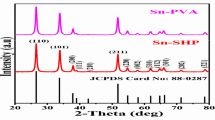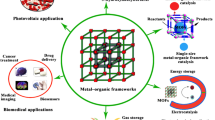Abstract
Here, a novel one-dimensional composite of poly(m-phenylenediamine)s coating on filamentous Streptomyces was successfully constructed via a controllable polymerization reaction. The synthesized composites were characterized by scanning electron microscopy, Fourier transform infrared spectroscopy, and X-ray photoelectron spectroscopy. Their adsorption isotherm and kinetics for aqueous hexavalent chromium were also systematically examined. The results of scanning electron microscopy analysis indicated that the obtained composites based on Streptomyces were showed a uniform and stable one-dimensional morphology with distinct core–shell configuration. Moreover, the Langmuir isotherm model (R 2 > 0.96) and pseudo-second-order equation (R 2 = 0.9996) described well the equilibrium adsorption behavior and kinetics of hexavalent chromium adsorption by the composites. In addition, bath adsorption experiments demonstrated the highest adsorption capacity of hexavalent chromium by the composites reached 320.03 mg g−1 in an acid solution, which was 5.6 times as that of the pure Streptomyces filaments. The results of Fourier transform infrared spectroscopy and X-ray photoelectron spectroscopy analyses suggested that the adsorption of hexavalent chromium by the composites possibly involved the protonation, redox, and chelation reactions. Therefore, a promising application of these composites in treating acid hexavalent chromium-contaminated wastewater is expectable.








Similar content being viewed by others
References
Chai LY, Wang YY, Zhao N, Yang WC, You XY (2013) Sulfate-doped Fe3O4/Al2O3 nanoparticles as a novel adsorbent for fluoride removal from drinking water. Water Res 47:4040–4049
Chai LY et al (2017) Heavy metals and metalloids in the surface sediments of the Xiangjiang River, Hunan, China: distribution, contamination, and ecological risk assessment. Environ Sci Pollut Res 24:874–885
Chen SH, Yue QY, Gao BY, Xu X (2010) Equilibrium and kinetic adsorption study of the adsorptive removal of Cr(VI) using modified wheat residue. J Colloid Interface Sci 349:256–264
Chen RH, Chai LY, Li QZ, Shi Y, Wang YY, Mohammad A (2013) Preparation and characterization of magnetic Fe3O4/CNT nanoparticles by RPO method to enhance the efficient removal of Cr(VI). Environ Sci Pollut Res 20:7175–7185
Colica G, Mecarozzi PC, De Philippis R (2010) Treatment of Cr(VI)-containing wastewaters with exopolysaccharide-producing cyanobacteria in pilot flow through and batch systems. Appl Microbiol Biotechnol 87:1953–1961
Deng SB, Ting YP (2005) Polyethylenimine-modified fungal biomass as a high-capacity biosorbent for Cr(VI) anions: sorption capacity and uptake mechanisms. Environ Sci Technol 39:8490–8496
Flärdh K, Buttner MJ (2009) Streptomyces morphogenetics: dissecting differentiation in a filamentous bacterium. Nat Rev Micro 7:36–49
Gupta VK, Agarwal S, Saleh TA (2011) Chromium removal by combining the magnetic properties of iron oxide with adsorption properties of carbon nanotubes. Water Res 45:2207–2212
Han J, Dai J, Guo R (2011) Highly efficient adsorbents of poly(o-phenylenediamine) solid and hollow sub-microspheres towards lead ions: a comparative study. J Colloid Interface Sci 356:749–756
Han X, Zhou TX, Xu SW, Li Y, Wang YF, Liu Y (2017) Removal of Cr(VI) and phenol coupled with the reduction of sulfate by sulfate-reducing bacteria sludge. Int J Environ Sci Technol. doi: 10.1007/s13762-017-1302-6
Huang MR, Peng QY, Li XG (2006) Rapid and effective adsorption of lead ions on fine poly(phenylenediamine) microparticles. Chemistry 12:4341–4350
Huang MR, Lu HJ, Li XG (2007) Efficient multicyclic sorption and desorption of lead ions on facilely prepared poly(m-phenylenediamine) particles with extremely strong chemoresistance. J Colloid Interface Sci 313:72–79
Jeon S, Yong K (2010) Morphology-controlled synthesis of highly adsorptive tungsten oxide nanostructures and their application to water treatment. J Mater Chem 20:10146–10151
Kholiya F, Chaudhary JP, Vadodariya N, Meena R (2016) Synthesis of bio-based aldehyde from seaweed polysaccharide and its interaction with bovine serum albumin. Carbohydr Polym 150:278–285
Li XG, Ma XL, Sun J, Huang MR (2009) Powerful reactive sorption of silver(I) and mercury(II) onto poly(o-phenylenediamine) microparticles. Langmuir 25:1675–1684
Li XL et al (2016) Bioaccumulation characterization of uranium by a novel Streptomyces sporoverrucosus dwc-3. J Environ Sci (China) 41:162–171
Liao YP, Min XB, Yang ZH, Chai LY, Liao Q, Wu BL (2014) Assessment of the stability of chromium in remedied soils by Pannonibacter phragmitetus BB and its risk to groundwater. J Soils Sedim 14:1098–1106
López-García M, Lodeiro P, Barriada JL, Herrero R, Sastre de Vicente ME (2010) Reduction of Cr(VI) levels in solution using bracken fern biomass: batch and column studies. Chem Eng J 165:517–523
Lu XF, Wang C, Wei Y (2009) One-dimensional composite nanomaterials: synthesis by electrospinning and their applications. Small 5:2349–2370
Min XB, Wang YY, Chai LY, Yang ZH, Liao Q (2017) High-resolution analyses reveal structural diversity patterns of microbial communities in chromite ore processing residue (COPR) contaminated soils. Chemosphere 183:266–276
Müller JM, Risse JM, Jussen D, Flaschel E (2013) Development of fed-batch strategies for the production of streptavidin by Streptomyces avidinii based on power input and oxygen supply studies. J Biotechnol 163:325–332
Öztürk A, Artan T, Ayar A (2004) Biosorption of nickel(II) and copper(II) ions from aqueous solution by Streptomyces coelicolor A3(2). Colloids Surf B 34:105–111
Petrus MLC, Claessen D (2014) Pivotal roles for Streptomyces cell surface polymers in morphological differentiation, attachment and mycelial architecture. Antonie Leeuwenhoek 106:127–139
Saurav K, Kannabiran K (2011) Biosorption of Cr(III) and Cr(VI) by Streptomyces VITSVK9 spp. Ann Microbiol 61:833–841
Su Z, Zhang LY, Chai LY, Wang HY, Yu WT, Wang T, Yang JX (2014) High-yield synthesis of poly(m-phenylenediamine) hollow nanostructures by a diethanolamine-assisted method and their enhanced ability for Ag+ adsorption. New J Chem 38:3984–3991
Wang XS, Huang LP, Li Y, Chen J, He W, Miao HH (2010) Uptake of Cr(VI) by Sphingomonas paucimobilis biomass from aqueous solutions. Sep Sci Technol 45:681–686
Wang HY, Li XR, Chai LY, Zhang LY (2015a) Nano-functionalized filamentous fungus hyphae with fast reversible macroscopic assembly & disassembly features. Chem Commun (Camb) 51:8524–8527
Wang T et al (2015b) Synthesis of core–shell magnetic Fe3O4@poly(m-phenylenediamine) particles for chromium reduction and adsorption. Environ Sci Technol 49:5654–5662
Wen Y, Tang ZR, Chen Y, Gu YX (2011) Adsorption of Cr(VI) from aqueous solutions using chitosan-coated fly ash composite as biosorbent. Chem Eng J 175:110–116
Xie AJ, Ji L, Luo SP, Wang ZL, Xu YY, Kong Y (2014) Synthesis, characterization of poly(m-phenylenediamine)/palygorskite and its unusual and reactive adsorbability to chromium(vi). New J Chem 38:777–783
Xu WH, Jian H, Liu YG, Zeng GM, Li X, Gu YL, Tan XF (2015) Removal of chromium (VI) from aqueous solution using mycelial pellets of Penicillium simplicissimum impregnated with powdered biochar. Biorem J 19:259–268
Yang SW, Liu D, Liao F, Guo TT, Wu ZP, Zhang TT (2012) Synthesis, characterization, morphology control of poly(p-phenylenediamine)-Fe3O4 magnetic micro-composite and their application for the removal of Cr2O7 2− from water. Synth Met 162:2329–2336
Yang WC, Tang QZ, Wei JM, Ran YJ, Chai LY, Wang HY (2016a) Enhanced removal of Cd(II) and Pb(II) by composites of mesoporous carbon stabilized alumina. Appl Surf Sci 369:215–223
Yang ZH, Zhang Z, Chai LY, Wang Y, Liu Y, Xiao RY (2016b) Bioleaching remediation of heavy metal-contaminated soils using Burkholderia sp. Z-90. J Hazard Mater 301:145–152
Yu WT, Zhang LY, Wang HY, Chai LY (2013) Adsorption of Cr(VI) using synthetic poly(m-phenylenediamine). J Hazard Mater 260:789–795
Zhang LY, Chai LY, Liu J, Wang HY, Yu WT, Sang PL (2011a) pH manipulation: a facile method for lowering oxidation state and keeping good yield of poly(m-phenylenediamine) and its powerful Ag+ adsorption ability. Langmuir 27:13729–13738
Zhang YW, Li HL, Luo YL, Shi X, Tian JQ, Sun XP (2011b) Poly(m-phenylenediamine) nanospheres and nanorods: selective synthesis and their application for multiplex nucleic acid detection. PLoS ONE 6:e20569
Zhang LY, Wang HY, Yu WT, Su Z, Chai LY, Li JH, Shi Y (2012) Facile and large-scale synthesis of functional poly(m-phenylenediamine) nanoparticles by Cu2+-assisted method with superior ability for dye adsorption. J Mater Chem 22:18244–18251
Zhang LY, Wang T, Wang HY, Meng Y, Yu WT, Chai LY (2013) Graphene@poly(m-phenylenediamine) hydrogel fabricated by a facile post-synthesis assembly strategy. Chem Commun (Camb) 49:9974–9976
Acknowledgements
The authors gratefully acknowledge the Key Scientific Research Project of Hunan Province, China (2016SK2004), and National Natural Science Foundation of China (51304250 and 51374237) for their financial support.
Author information
Authors and Affiliations
Corresponding author
Additional information
Editorial responsibility: Tanmoy Karak.
Electronic supplementary material
Below is the link to the electronic supplementary material.
Figure 1
SEM image of the Streptomyces@PmPDs composites by ultrasonic treatment for 1 h (TIFF 406 kb)
Figure 2
The linearized Langmuir isotherm fit of the pure Streptomyces filaments (1), Streptomyces@PmPDs-1 (2), Streptomyces@PmPDs-2 (3), Streptomyces@PmPDs-3 (4) and Streptomyces@PmPDs-4 (5) (TIFF 369 kb)
Figure 3
The linearized Freundlich fit of the pure Streptomyces filaments (1), Streptomyces@PmPDs-1 (2), Streptomyces@PmPDs-2 (3), Streptomyces@PmPDs-3 (4) and Streptomyces@PmPDs-4 (5) (TIFF 399 kb)
Figure 4
Regeneration property of Streptomyces@PmPDs-2 for Cr(VI) adsorption (TIFF 380 kb)
Figure 5
The concentrations of total Cr and Cr(III) in the filtrate after Cr(VI) adsorption on Streptomyces@PmPDs-2. Adsorption conditions: 15 mg of the composites, 5 h, T = 30 oC and 20 ml of 40 and 100 mg L−1 Cr(VI) solution, respectively. The Cr(III) concentration is the concentration of total Cr species minus that of Cr(VI) (TIFF 401 kb)
Figure 6
The concentrations of varies Cr species in the filtrate after Cr(VI) adsorption on Streptomyces@PmPDs-2. Adsorption conditions: 120 mg of the composites, pH = 2, T = 30 °C, 160 ml of 100 mg L−1 Cr(VI) solution. The Cr(III) concentration is the concentration of total Cr species minus that of Cr(VI) (TIFF 412 kb)
Figure 7
The final pH of the solution after Cr(VI) adsorption with Streptomyces@PmPDs-2 (TIFF 367 kb)
Table 1
Kinetic parameters (XLS 39 kb)
Rights and permissions
About this article
Cite this article
Chai, L.Y., Wang, X., Wang, H.Y. et al. Formation of one-dimensional composites of poly(m-phenylenediamine)s based on Streptomyces for adsorption of hexavalent chromium. Int. J. Environ. Sci. Technol. 15, 1411–1422 (2018). https://doi.org/10.1007/s13762-017-1500-2
Received:
Revised:
Accepted:
Published:
Issue Date:
DOI: https://doi.org/10.1007/s13762-017-1500-2




